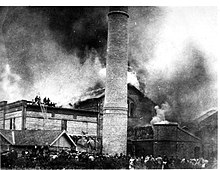Borghorster Warps Spinning Mill
| Borghorster Warps Spinning Mill | |
|---|---|
| legal form | GmbH & Co. KG |
| founding | 1861 |
| resolution | 2005 |
| Reason for dissolution | insolvency |
| Seat | Borghorst , Gantenstrasse 4th |
| Number of employees | 545 (1929) |
| Branch | Cotton and synthetic spinning, dyeing, bleaching, sizing |
The Borghorster Warps-Spinnerei was a company that existed in Borghorst from 1861 to 2005 and dealt with the manufacture of warp yarn .
history
In 1856, based on the English model, a sizing shop was built in Borghorst, including a flour mill to deliver the sizing material, in order to avoid the high import duties for the sizing English yarn. The builders and operators were Johann Heinrich Brader from Zwischenahn near Oldenburg and his brother-in-law Johann Heinrich Rabe, who had acquired their practical knowledge in England. In 1857 the Borghorster linen and nettle publishers Joseph Wattendorff , Bernhard Josef Kock and BJ Hageböck acquired shares in the company, so that the company could be expanded to include a mechanical spinning mill with 16,000 spindles and a mechanical weaving mill in 1860 with additional capital and know-how. It was now called " Rabe, Brader and Co. ".
After Bernhard Josef Kock's death in 1859, Arnold Kock, his brother Franz Kock and Werner Frieling took over the factories and holdings of their deceased uncle. In 1861 they parted with the Hageböck, Kock and Wattendorf families from the "Rabe, Brader and Co" company. and together with her brother-in-law Joseph Wattendorff and her uncle's second wife, Elisabeth Messing, founded their own spinning mill, which they called “ Borghorster Warps-Spinnerei Kock und Comp. ", Abbreviated to" BWS ". "Warp" is the English name for warp yarn. The company started with 4,000 spindles and expanded rapidly: by 1880 it was already working with 24,000 spindles. In 1898 a ring spinning mill was built by Sidney Scott, increasing the capacity to 40,000 spindles by 1905.
In 1899 Bernard Bartmann , Joseph Wattendorff's son-in-law, joined the Borghorster Warps spinning mill as a personally liable partner.
In 1906 BWS took over the " SW Borghorst " spinning and weaving mill at Gantenstrasse 2, which had been created by the Rabe, Brader & Co. company , whose business had been in decline in the previous years. A year later, however, a major fire destroyed the facilities at SW Borghorst . Immediately afterwards, Bartmann took care of the reconstruction of the factory building on Gantenstrasse and converted it into the new BWS company headquarters using the most modern aspects . In 1912 Bartmann made from the operation to in Wegberg own cotton mill, the subsequent spinning company Wegberg build.
In 1928 the capacity of the BWS had increased to 53,000 spindles. Were offered cotton yarns, simple and twisted, raw, bleached and dyed . The company employs around 545 people and has a steam engine from MAN with 2,200 hp.
In 2005 the company was dissolved due to bankruptcy. After that, the production buildings at Gantenstrasse 2-8 were completely demolished. A large shopping center, the BWS Center, was built on the cleared area of over 13,000 m² . In 2008 one of the two factory chimneys was blown up, but the other with the iron fire-fighting water tank was preserved as a striking reminder of the era of the textile industry in Borghorst, was placed under monument protection and renovated. The chimney also serves as an antenna carrier for the cellular network of Telefonicá Deutschland (o2 / E-Plus), with the GSM, UMTS and LTE technologies (as of June 2020). The system technology required for this is located below inside the chimney, accessible through a steel door and in metal racks outside the tower on the ground.
literature
- Karl Bartmann: On the history of the Bartmann family from Herbern. Wuppertal 1992.
- Hans-Jürgen Warnecke: The historical development of the Borghoster textile industry. In: Westfälische Nachrichten. No. 115, Borghorst May 17, 1968.
- Hans-Jürgen Warnecke: From home weaving to the textile industry. In: 1000 years of Borghorst. ed. by Wilhelm Kohl. Borghorst 1968, pp. 77-89.
- Franz-Josef Dwersteg: When things were still spinning on Emsdettener Straße, photo exhibition “Borghorst 50 years ago” by Bernhard Hülsmann in the Heimathaus. In: Westfälische Nachrichten . Edition Steinfurt, October 11, 2012 (With photo of the spinning mill from 1962)
- Josef Stenkamp: Cotton mills for the continent. Sidney Scott and the English spinning mill in Münsterland and Twente. ed. from the Textile Museum Bocholt . Verlag Klartext, Essen 2005, ISBN 3-89861-458-1 / ISBN 978-3-89861-458-0 .
Web links
- Borghorster Warps-Spinnerei from Firmenwissen de, accessed on November 3, 2017
- Borghorster Warps-Spinnerei from Albert Giesler.de, accessed on November 3, 2017
Individual evidence
- ^ Textile Museum Bocholt 2005.
- ^ Steam engine list of the Maschinenfabrik Augsburg-Nürnberg AG, Nuremberg plant from March 25, 1928.
- ↑ Entry from May 4, 2005 on HRA 1398 at the Steinfurt District Court
- ^ BWS-Center-moves-the-Borghorster. In: Westfälische Nachrichten . Borghorst, August 1, 2007.
- ^ Press release from the Steinfurt district : The chimney of the former Borghorster Warps spinning mill (BWS) will be blown up next Thursday, October 30th, at 2 p.m. This means that one of the last striking structures is disappearing from the area that is currently being extensively renovated by the Steinfurt district and the NRW Altlastensanierungsverband NRW (AAV). On this day, the streets “Auf dem Windhorst” and “Nünningsweg” as well as the adjoining cycle and residential paths in the vicinity of the BWS will be closed between 12 noon and 3 pm. Steinfurt, October 28, 2008.

